
Fig.1
Pieter Casteels
A Fable from Aesop: The Vain Jackdaw 1723
Oil on canvas
1826 x 2526 mm
T15637

Fig.2
The reverse of A Fable from Aesop: The Vain Jackdaw
The painting (fig.1) is on a medium-weight plain weave canvas, lined prior to acquisition with glue paste to a lighter but still medium-weight and plain weave canvas, and provided with a new stretcher (fig.2). There are several repaired damages, possibly tears or holes, and the turnover edges of the canvas, which rarely survive an early lining treatment, have become very weak, and have been temporarily patched to prevent loss of canvas.
The ground appears to be beige in colour. Underdrawing is not discernible by eye.
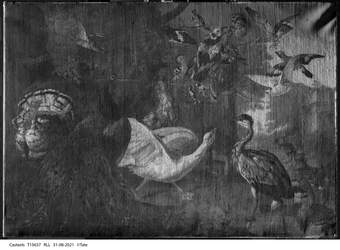
Fig.3
A Fable from Aesop: The Vain Jackdaw viewed in raking light from the left side

Fig.4
Detail of leaves in the centre of the foreground
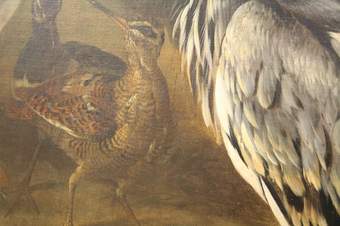
Fig.5
Detail of the heron’s breast feathers
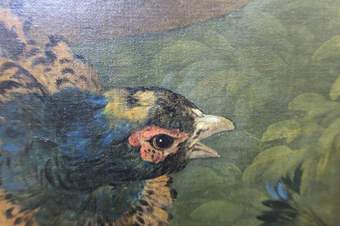
Fig.6
Detail of the head of the pheasant perched on the fragment of a carved frieze
The paint was applied thinly (fig.3),1 in areas such as the foreground allowing the beige ground to show through (fig.4). The birds were precisely rendered (figs.5–6) while the landscape appears more painterly, though with less attention to detail. Some low impasto is present in white feathers, and the paint consistency appears relatively fluid and well-bound with some areas of wet-in-wet mixing visible throughout.
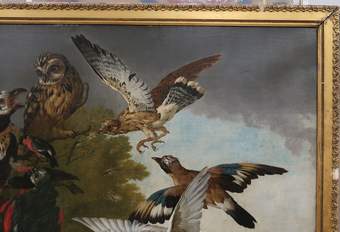
Fig.7
Detail of the upper right corner
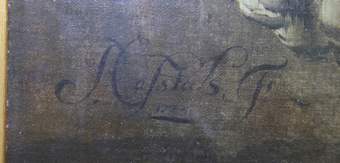
Fig.8
Detail of the signature
There is extensive and skilfully executed retouching throughout, likely relatively recently before acquisition indicating significant wear to the paint. The worn paint is most noticeable in the sky and distant trees (fig.7) There are a few filled and retouched losses where the surface texture is slightly mismatched. Fine age cracking is visible throughout. There are some clusters of old tiny losses beneath the varnish, and the impasto has been slightly flattened by the lining process There is increased transparency in some paint layers, for example the foliage at bottom centre, where the dark underlayers show through clearly (fig.4). In the foreground foliage and the peacock’s tail feathers, fading of a yellow pigment used in combination with a blue one to make an optical green has left the leaves with a bluish cast (fig.4).
There is a signature in the lower half of the left edge (fig.8).
The present varnish is not the original one. Patchy residues of an earlier natural resin varnish are visible in ultraviolet light, indicating that previous cleaning has been carried out unevenly.
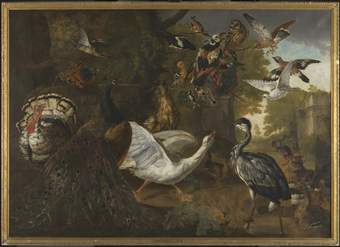
Fig.9
The painting in its present frame
At acquisition the painting was fitted in a non-original gilded wooden frame (fig.9) with compo ornament (fig.4) and a simple tablet.2 This appears to be part of a larger frame of which this is the inner frame, composed of pine wood. The profile is composed of a flat with a shallow step down to narrower flat and at the sight edge an unusually small cavetto. It is gilded with two runs of composition ornament. From the type of ornament and the frame profile, it could be dated between 1880 and 1900.
January 2022
